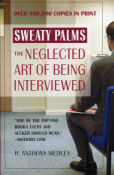| What REALLY goes on in a job interview? Find out in the new revision of "Sweaty Palms: The Neglected Art of Being Interviewed" (Warner Books) by Tony Medley, updated for the world of the Internet . Over 500,000 copies in print and the only book on the job interview written by an experienced interviewer, one who has conducted thousands of interviews. This is the truth, not the ivory tower speculations of those who write but have no actual experience. "One of the top five books every job seeker should read," says Hotjobs.com. | |
| A Good Year (7/10) by Tony Medley Far be it from me to come down hard on a film with Russell Crowe and Abbie Cornish, two of my favorite actors. But let’s get the main criticism out of the way at the start. At somewhere near two hours, this “fish-out-of-water/coming-of-age” film is just too long. Something must be wrong with me. Recently I find myself liking movies I would normally disdain. This is one of those. A film with a weak script and a weaker story, I came out thinking that it was nothing to recommend. But it continued to pop up in my thoughts in favorable terms. I generally dont do that, certainly not about films like this, something that advertises itself as a romantic comedy, that is neither very romantic nor very funny. Max Skinner (Crowe) is a hotshot stock trader who inherits a vineyard estate in Provence, France from his Uncle Henry (Albert Finney). A cold, selfish man who hasn’t seen his beloved uncle in ten years, Max immediately takes off for the place in order to sell it as fast as he can. But once he gets there he becomes reacquainted with Francis Duflot (Didier Bourdon), who is the caretaker of the estate along with his wife, Mme. Duflot (Esabelle Candelier, who director Ridley Scott calls “the French Lucille Ball”), meets Fanny Chenal (Marion Cotillard), a local café owner, of whom he becomes enamored, and Henry’s illegitimate daughter, Christie (Cornish), whom he thinks about “shagging,” even if she is his first cousin. As a result of all this, he is forced to rethink the priorities he has set in his life. If there’s one term that’s coming into use today, at least in movies, that I find childish, it’s the term “shag.” It sounds like a college kid who claims a lot more than he gets. I think we already have too many laws, but I wouldn’t oppose a law that imposed capital punishment without trial on anyone who used it. While I’m at it, is this a one-way term, or can a woman “shag” a man? Back to the movie, the story is told with occasional flashbacks to show Max’s relationship with Uncle Henry when Max (Freddy Highmore plays little Max) was growing up. These scenes create the nostalgia for the place that keeps attacking Max when he takes the time to think. There’s just not enough in the script (Marc Klein, based on a book by Peter Mayle) to justify sitting through this for almost two hours, even if it is a pleasure to look at Cornish and Cotillard, although, after having seen Cornish in Somersault, one of the hottest films I’ve ever seen, I truly did not recognize her with her clothes on. I also liked the music (Marc Streitenfeld), who used many standards as the score, including “Old Cape Cod” and “Itsy Bitsy Teeny Weeny Yellow Polka Dot Bikini” (based on “La fleur que tu m’avais jetee” from Bizet’s Carmen) in French. You’ll have to stay for some of the closing credits to hear the latter. One thing this film does have, however, is staying power. I found myself thinking about it and remembering it the next day, which I rarely do with films. The atmosphere of living in Provence is captured with scintillating romance. The cinematography (Philippe Le Sourd) and Production Design (Sonja Klaus) are impeccable. Klaus did exceptional work to make the slightly dilapidated, bug-infested house have the feel of shabby chic, lived-in and homey. Le Sourd almost converts the film into a series of picture-postcard images of quaint French villages. Despite the failings of the script and the story, it was the ambience that these people created that made the film an enjoyable experience for me. Instead of decrying the lack of a compelling story, or the fact that it is not a very funny romantic comedy, I just sat back as if I were a fly on the wall observing life in Provence, lived by people like Russell Crowe and Abbie Cornish. What’s wrong with that? November 8, 2006
|
|
|
|
|
